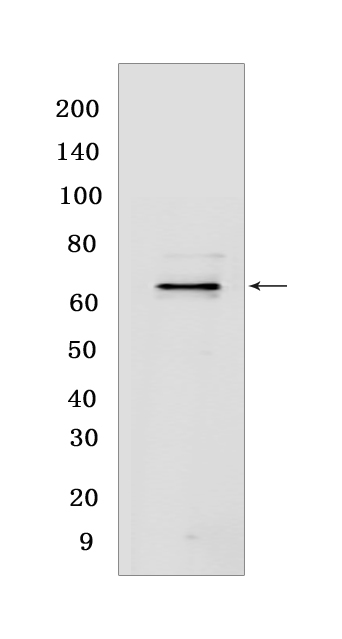YTHDF2 Rabbit mAb [RD7Y]Cat NO.: A92623
Western blot(SDS PAGE) analysis of extracts from HeLa cells.Using YTHDF2 Rabbit mAb [RD7Y] at dilution of 1:1000 incubated at 4℃ over night.
Product information
Protein names :YTHDF2,HGRG8,YTHD2_HUMAN,YTH domain-containing family protein 2
UniProtID :Q9Y5A9
MASS(da) :62,334
MW(kDa) :65 kDa
Form :Liquid
Purification :Protein A purification
Host :Rabbit
Isotype :IgG
sensitivity :Endogenous
Reactivity :Human,Mouse,Rat
- ApplicationDilution
- 免疫印迹(WB)1:1000-2000
- The optimal dilutions should be determined by the end user
Specificity :Antibody is produced by immunizing animals with a synthetic peptide at the sequence of Human YTHDF2
Storage :Antibody store in 10 mM PBS, 0.5mg/ml BSA, 50% glycerol. Shipped at 4°C. Store at-20°C or -80°C. Products are valid for one natural year of receipt.Avoid repeated freeze / thaw cycles.
WB Positive detected :HeLa cells
Function : Specifically recognizes and binds N6-methyladenosine (m6A)-containing RNAs, and regulates their stability (PubMed:24284625, PubMed:26046440, PubMed:26318451, PubMed:32492408). M6A is a modification present at internal sites of mRNAs and some non-coding RNAs and plays a role in mRNA stability and processing (PubMed:22575960, PubMed:24284625, PubMed:32492408, PubMed:25412658, PubMed:25412661). Acts as a regulator of mRNA stability by promoting degradation of m6A-containing mRNAs via interaction with the CCR4-NOT and ribonuclease P/MRP complexes, depending on the context (PubMed:24284625, PubMed:26046440, PubMed:27558897, PubMed:30930054, PubMed:32492408). The YTHDF paralogs (YTHDF1, YTHDF2 and YTHDF3) share m6A-containing mRNAs targets and act redundantly to mediate mRNA degradation and cellular differentiation (PubMed:28106072, PubMed:32492408). M6A-containing mRNAs containing a binding site for RIDA/HRSP12 (5'-GGUUC-3') are preferentially degraded by endoribonucleolytic cleavage: cooperative binding of RIDA/HRSP12 and YTHDF2 to transcripts leads to recruitment of the ribonuclease P/MRP complex (PubMed:30930054). Other m6A-containing mRNAs undergo deadenylation via direct interaction between YTHDF2 and CNOT1, leading to recruitment of the CCR4-NOT and subsequent deadenylation of m6A-containing mRNAs (PubMed:27558897). Required maternally to regulate oocyte maturation: probably acts by binding to m6A-containing mRNAs, thereby regulating maternal transcript dosage during oocyte maturation, which is essential for the competence of oocytes to sustain early zygotic development (By similarity). Also required during spermatogenesis: regulates spermagonial adhesion by promoting degradation of m6A-containing transcripts coding for matrix metallopeptidases (By similarity). Also involved in hematopoietic stem cells specification by binding to m6A-containing mRNAs, leading to promote their degradation (PubMed:30065315). Also acts as a regulator of neural development by promoting m6A-dependent degradation of neural development-related mRNA targets (By similarity). Inhibits neural specification of induced pluripotent stem cells by binding to methylated neural-specific mRNAs and promoting their degradation, thereby restraining neural differentiation (PubMed:32169943). Regulates circadian regulation of hepatic lipid metabolism: acts by promoting m6A-dependent degradation of PPARA transcripts (PubMed:30428350). Regulates the innate immune response to infection by inhibiting the type I interferon response: acts by binding to m6A-containing IFNB transcripts and promoting their degradation (PubMed:30559377). May also act as a promoter of cap-independent mRNA translation following heat shock stress: upon stress, relocalizes to the nucleus and specifically binds mRNAs with some m6A methylation mark at their 5'-UTR, protecting demethylation of mRNAs by FTO, thereby promoting cap-independent mRNA translation (PubMed:26458103). Regulates mitotic entry by promoting the phase-specific m6A-dependent degradation of WEE1 transcripts (PubMed:32267835). Promotes formation of phase-separated membraneless compartments, such as P-bodies or stress granules, by undergoing liquid-liquid phase separation upon binding to mRNAs containing multiple m6A-modified residues: polymethylated mRNAs act as a multivalent scaffold for the binding of YTHDF proteins, juxtaposing their disordered regions and thereby leading to phase separation (PubMed:31388144, PubMed:31292544, PubMed:32451507, PubMed:31642031). The resulting mRNA-YTHDF complexes then partition into different endogenous phase-separated membraneless compartments, such as P-bodies, stress granules or neuronal RNA granules (PubMed:31292544). May also recognize and bind RNAs modified by C5-methylcytosine (m5C) and act as a regulator of rRNA processing (PubMed:31815440).., (Microbial infection) Promotes viral gene expression and replication of polyomavirus SV40: acts by binding to N6-methyladenosine (m6A)-containing viral RNAs (PubMed:29447282).., (Microbial infection) Promotes viral gene expression and virion production of kaposis sarcoma-associated herpesvirus (KSHV) at some stage of the KSHV life cycle (in iSLK.219 and iSLK.BAC16 cells) (PubMed:29659627). Acts by binding to N6-methyladenosine (m6A)-containing viral RNAs (PubMed:29659627)..
Tissue specificity :Highly expressed in induced pluripotent stem cells (iPSCs) and down-regulated during neural differentiation..
Subcellular locationi :Cytoplasm, cytosol. Cytoplasm, P-body. Cytoplasm, Stress granule. Nucleus.
IMPORTANT: For western blots, incubate membrane with diluted primary antibody in 1% w/v BSA, 1X TBST at 4°C overnight.


